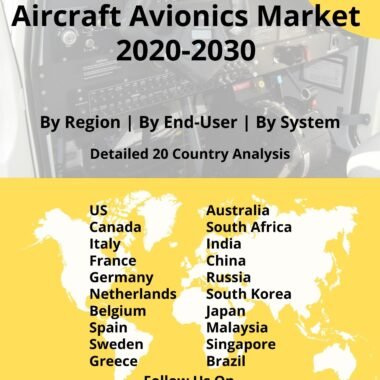Description
Global Aircraft LRU Market
Frequently Asked Questions of ALRU Market
LRUs are advanced assemblies that serve as sub-system interfaces for flight management, heads-down displays, and other aircraft system operations. These devices employ microcontrollers or Field Programmable Gate Arrays (FPGA) to produce high-reliability information display and control features. A leap forward for open architecture design is the anticipated usage of “digital backbones”. Separating the aviation system’s digital backbone from the aircraft’s mission systems reduces the potential that any future changes or upgrades to the mission systems will have an undesirable influence on the aviation network. This strategy promises to simplify and accelerate technology renewal for these helicopters for years to come, minimizing the need to recertify the entire aircraft bus architecture as well as the necessity for regression testing anytime new technologies or capabilities are added.
The Future Airborne Capability EnvironmentTM (FACE) Approach is a software standard established by the government and industry. The FACE Approach combines technological and business practices to create a standard shared operating environment with transferable capabilities across avionics systems.
The FACE Technical Standard provides the specifications for architectural segments and essential interfaces that bring the segments together. This allows capability-based software components to be reused across diverse hardware computing environments. It also allows for the rapid replacement of existing software as well as the introduction of new and improved capabilities during the system’s lifecycle. The FACE Approach is relevant to both lasting systems and future systems, including new system designs, system-level upgrades, and component upgrades.
Major factors driving Aircraft LRU Market Growth
Aircraft LRU market will be driven by increasing demand for open architecture systems. Armed forces around the world are moving towards interoperability with increasing emphasis on network centric warfare. These market trends will drive the growth of the LRU market.
Trends influencing the Aircraft-Line Replacement Unit Market Size
Lightweight and small form factor LRU will be the main market trend that will influence the growth of the market. Compliance with open architecture and upcoming standards such as Modular Open Systems Architecture (MOSA) will also be one of the key market trend.
Aircraft-Line Replacement Unit Market Forecast & Dynamics
Increasing defense spending will drive the market for new procurement activities and upgrades to existing platforms with newer capabilities. The increase in defense spending will encourage procurement of new aircrafts such as transport aircrafts, fighter aircrafts, helicopters and unmanned systems. Procurement will also be driven by prevailing geo political conditions in Europe and the Asia Pacific.
Market Analysis for Recent Developments
The Future Vertical Lift (FVL) program, one of the United States Army’s most critical and game-changing efforts, is fully adopting the open architecture design philosophy for the next-generation helicopters that will replace the OH58 Kiowa Warrior, AH64 Apache, and UH60 Black Hawk rotorcraft. These initiatives are a true watershed moment for the Modular Open Systems Architecture (MOSA) concept. The Army sees MOSA as the way to establishing an objective architecture for both aircraft and mission systems electronics that will give more control over the system-upgrade process.
Furthermore, MOSA will assist the government in achieving its goal of establishing commonality between the two winning aircraft designs whenever practicable. Because of this commonality, the Army will no longer have to rely solely on the prime contractor to modernize a system. Instead, the subsystem architecture will be described with enough precision that the government will be able to meet update requirements through third-party providers, fostering competition, interoperability, and cost savings. Going ahead, the MOSA method will give the Army with greater flexibility, cut time to deployment, and deliver long-term savings.
AeroVironment has been awarded a $11 million contract by the Army Contracting Command at Redstone Arsenal in Alabama. Unmanned aircraft system RQ-20 Puma Long-Endurance (LE) for surveillance missions. When combined with the AeroVironment long-range tracking antenna, the hand-launched Puma LE has an operational range of 37.3 miles over land and sea. For day and night operations, operators can switch between the Mantis i45 and the optional Mantis i45 N. Its interoperable, plug-and-play line-replaceable unit (LRU) components can be exchanged with other Puma all-environment (AE) aircraft.
Genesys Aerosystems Inc. Selected for HAL HINDUSTAN-228 Upgrade. HAL’s work with the S-TEC 4000R autopilot system will bring the latest digital autopilot system to the HINDUSTAN-228 platform, as well as additional features such as VNAV capability and better safety to the HINDUSTAN-228 aircraft. The initiative will also provide almost 20 years of extended platform support. The S-TEC 4000R is a three-axis, attitude-based, remote-mounted flight control system developed for Class 4, Part 23 aircraft. The S-TEC 4000R incorporates a separate flight guidance computer (FGC) and mode control panel (MCP) for optimum flexibility in avionics LRU placement within aircraft with limited space. The MCP is made of buttons that allow the pilot to control the autopilot mode that has been selected.
BEL and DRDO reach an agreement for the Advanced Medium Combat Aircraft program. By working together, the two organizations will develop, produce, and deliver Internal Weapon Bay Computers and other line replaceable units (LRU) for fighter aircraft, all while utilizing the complementing strengths and capabilities of BEL and ADA. In order to develop, produce, and provide internal weapon bay computers and other line replaceable units (LRU) for fighter aircraft, both sides will work together. After the AMCA is implemented, BEL will also offer the Indian Air Force (IAF) lifelong product support. An aircraft’s LRU is a part that can be easily changed at an operational site. The flight management system exemplifies LRU. After completing the AMCA’s design, the DRDO will move on to the Critical Design Review (CDR) phase. A CDR is a technical evaluation that verifies an aircraft’s system can meet performance requirements and move forward with manufacture, testing, and demonstration. At the recently held Aero India event in Bengaluru, the AMCA’s internal weapons bay was also unveiled. An aircraft’s internal weapons bay is a compartment designed to hold bombs.







